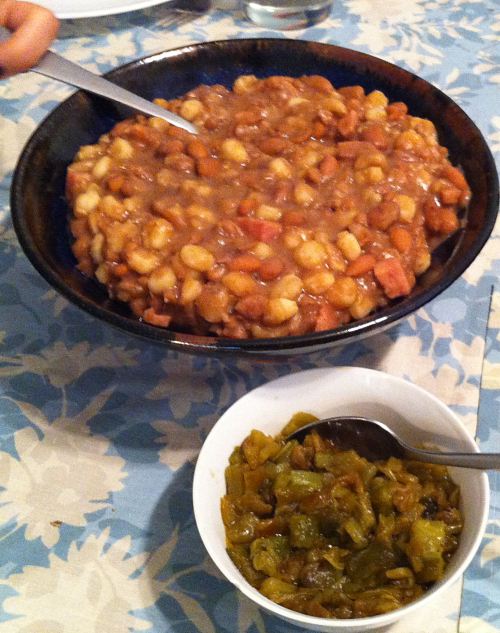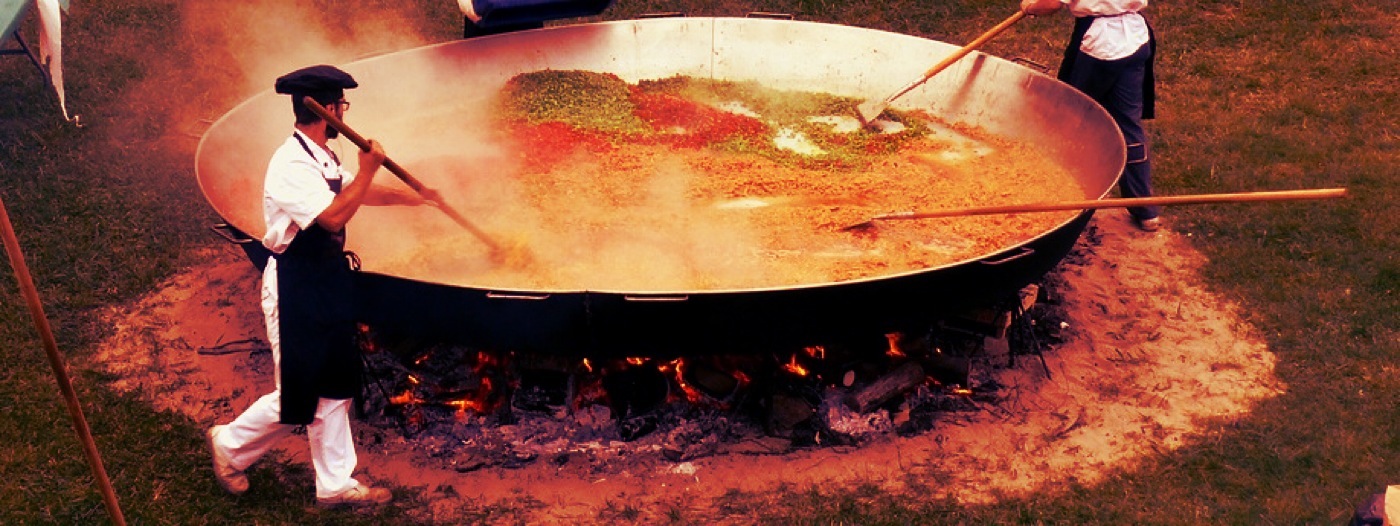Jan recently came back from Hopi, and had high praise for Hopi beans and hominy. I decided to do a Hopi/Southwestern Indian meal for last Sunday. In addition, to Hopi beans and hominy, I am making Southwestern Indian chicken and blue corn tortillas.

Hopi Pinto Beans and Hominy
My wife, Jan, visits her friends in Hopi in every few years. One year, her friend gave her a copy of authentic Hopi recipes that were modified by the Hopi Health Services to be low fat, low sodium, and sugar free. Although I will usually adapt a recipe and call it my own, many of the recipes in this book are too simple to be changed.
Note: Most of the recipes in the Hopi cookbook are very sparse (3-6 ingredients). Like Japanese cuisine the aesthetic is to emphasize the flavor of the primary ingredient, not to cover or hide it with a multitude of other flavors.
Traditional Hopi cuisine was based on what they had and in that desert environment there was not a lot. They had sheep, rabbits, pinto bean, blue corn, squash, and a few local herbs. This last point is what makes it hard to replicate many of the recipes outside of Hopi—your local supermarket does not carry nanakopsi, muhha, siswa, or muntochabvu.
Culinary ash is also an important element of their diet. It is used to make a mineralized lye water that—in addition to keeping blue corn meal blue after cooking—adds sodium, potassium, calcium, magnesium, manganese, iron, copper, zinc, bromine, rubidium and strontium to their diet.
The ash is also used to make Hopi hominy. Home grown corn is dried and then soaked in the ash water to remove the hulls. This process adds the minerals and a unique flavor. Commercial hominy—which is made with processed lye which lacks the additional minerals—is a less nutritious, but a more available alternative.
Note: The process of soaking corn in lye is called nixtamalization. In addition to removing the indigestible hulls, it chemically frees the corn’s bound niacin, making it possible for the body to absorb it.
Since I was using canned hominy, I decided to save time by using canned beans. American’s test kitchen has claimed that using Goya beans can be every better than using dried beans. One thing I have noticed about these beans is that they tend to be a bit under-cooked and give me gas. To solve this problem, I decided to cook the beans and hominy for an extended period.
Note: The Hopi do not put chilies into the beans while they are cooking, bit they may roast them and serve them as a side for anyone who wishes to “spice up” their beans and hominy.
After Dinner Note: This may have been a pale imitation of what Jan and Eilene had on the reservation, but Jan said it was close. The next time, I will get hold of the proper speckled Flint corn and turn it into Hopi hominy with culinary ash.
Hopi Beans and Hominy
Ingredients
29 oz. can pinto beans (Goya)
25 oz. Mexican-style hominy
1 tsp. Kosher salt
½ cup lean ham, diced (leave out ham for Vegan/vegetarian)
(Optional) 3-4 Anaheim or New Mexican chilies
Directions
1. Pour the contents of the cans of beans and hominy—with their liquids—into a Dutch oven, over a medium heat.
2. Bring the pot to a boil, cover and reduce the heat to a simmer.
3. Simmer the beans for one hour, stirring occasionally.
Tip: Scrape the bottom of the pot to prevent scorching.
4. Stir in the ham and salt.
5. Continue simmering until the beans have thickened to your desired thickness, another hour.
Tip: You may add everything at once and cook the beans for only half an hour—everything is actually already cooked—but it may cause gas and will not be the same as the Hopi prepare the beans and hominy.
Note: The Hopi woman that Jan stayed with started with dry beans and hominy. She added them to a slow-cooker in the evening and added the ham, salt and plenty of water. The timer was set to start cooking at 4 AM. and the stew was then slow cooked until noon.
6. While the beans and corn are simmering, stem, cut all the of peppers in half lengthwise, and remove the seeds.
Tip: Many people roast their chilies whole and then the struggle with a hot floppy pepper, trying to remove the seeds. By cutting the peppers in half, it is easier to remove the seeds first. This has the added benefits—saving both time and energy—of being able to sear both sides of the chilies at the same time.
7. Set the pepper halves, cut side down, on the foil-lined, lipped baking sheet.
8. Broil the peppers 6 inches from the heating element for 15 minutes, until the skins are well blackened.
9. Set the baking sheet on the counter, so that the vegetables can cool.
10. Remove the skins from the peppers and coarsely chop them.
11. Place the beans and hominy in a serving bowl with the roasted peppers on the side.

Awesome! There are not too many authentic Native American recipes out there. Thanks for sharing!
Pingback: Karl’s Southwestern Indian Chicken | Jabberwocky Stew
Pingback: Hopi Blue Tortillas | Jabberwocky Stew
Pingback: Karl’s Nayarit Pozole Roja | Jabberwocky Stew
I HAVE MANY OF NATIVE AMERICAN RECIPES THAT WE CONSUMED AS KIDS. ONE WAS BANNOCK AND ROSE HIP JAM. WE PICKED OUR OWN TEA. MY FAVORITE WAS WILD JUNEBERRY SYRUP.CARROTS GREW WILD ALONG WITH ONIONS FOR A GOOD DEER SOUP.CHOKE CHERRY PATTIES YUM YUM.
Pingback: Karl’s Pinto Beans and Hominy | Jabberwocky Stew